Hikari (train)
Hikari (ひかり, "Light") is the name of a high-speed train service running on the Tokaido and San'yō Shinkansen "bullet train" lines in Japan. Slower than the premier Nozomi but faster than the all-stations Kodama, the Hikari is the fastest train service on the Tokaido and Sanyo Shinkansen that can be used with the Japan Rail Pass.
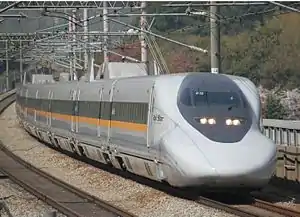 700 series Hikari Rail Star, April 2009 | |
| Overview | |
|---|---|
| Service type | Shinkansen |
| First service | 25 April 1958 (Express) 1 October 1964 (Shinkansen) |
| Current operator(s) | JR Central, JR West |
| Former operator(s) | JNR |
| Route | |
| Line(s) used | Tōkaidō Shinkansen San'yō Shinkansen |
| On-board services | |
| Class(es) | Green + Standard |
| Catering facilities | Trolley refreshment service |
| Technical | |
| Rolling stock | 700/N700 series |
| Track gauge | 1,435 mm (4 ft 8 1⁄2 in) standard gauge |
| Electrification | 25 kV AC, 60 Hz |
| Operating speed | 285 km/h (177 mph) (Tōkaidō) 300 km/h (190 mph) (Sanyō)[1] |
Service variations
West Hikari

These services first appeared in 1988 on the Sanyo Shinkansen between Shin-Osaka and Hakata using 6-car 0 series trains. 0 series 12-car SK units were employed on these services from 1989. From 11 March 2000, they were mostly replaced by the new 700 series Hikari Rail Star services, and were finally withdrawn on 21 April 2000.
Grand Hikari
These were the premier services operated between Tokyo and Hakata from 11 March 1989 using JR West 16-car 100 series V sets with four double-deck centre cars including a restaurant car.[2] These operated at a maximum speed of 230 km/h on the Sanyo Shinkansen (compared to 220 km/h for other Hikari services).[3] From 11 March 2000, restaurant car services were discontinued on all trains, and from May 2002 onwards, the few remaining Grand Hikari services were limited to the Sanyo Shinkansen only. The last Grand Hikari ran in November 2002.

Family Hikari
First appearing in the summer of 1995, these seasonal services operated between Shin-Osaka and Hakata during holiday periods using special 6-car 0 series sets (R2 and R24) which included a children's play area in car 3. All seats were reserved on these services.
Hikari Rail Star
JR West began operating the Hikari Rail Star service from the start of the new timetable on 11 March 2000. This service is limited to the Sanyo Shinkansen line, and uses special 8-car 700-7000 series trains with a distinctive livery and a maximum speed of 285 km/h. JR West introduced the service to provide better competition against airlines on the Osaka-Fukuoka route. These services do not have Green car accommodation, but the reserved seating cars feature 2+2 seating and also some 4-seat compartments instead of the standard 3+2 arrangement in non-reserved seating cars. The front row of seats in these cars feature power outlets for laptop users. With most Hikari Rail Star services being replaced by through Kyushu Shinkansen Sakura services from 12 March 2011, the 8-car 700 series sets used on the service have been running mostly on all-stations Kodama services on the Sanyo Shinkansen line. As of 14 March 2020, the Hikari Rail Star is the only special service variation to run on the Hikari service.
Rolling stock
- 700 series 8-car E sets
- N700A series 16-car X/K sets, modified from N700 series Z/N sets
- N700 series 8-car S/R sets
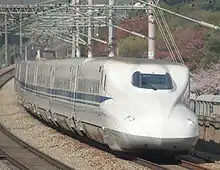 JR West N700 series, April 2009
JR West N700 series, April 2009
Former rolling stock
- 0 series
- 100 series
- 300 series
- 500 series
- 700 series 16-car B/C sets
 0 series, 1987
0 series, 1987 100 Series, 1987
100 Series, 1987 JR West 300 series, 8 October 2008
JR West 300 series, 8 October 2008 JR West 500 series, May 2012
JR West 500 series, May 2012 JR Central 700 series, April 2009
JR Central 700 series, April 2009
Train formations
N700 series (16 cars)
16-car N700 series services are formed as follows with car 1 at the Hakata end and car 16 at the Tokyo end. All cars are no smoking except for smoking compartments located in Cars 3, 7, 10, and 15.[4]
| Car No. | 1 | 2 | 3 | 4 | 5 | 6 | 7 | 8 | 9 | 10 | 11 | 12 | 13 | 14 | 15 | 16 |
|---|---|---|---|---|---|---|---|---|---|---|---|---|---|---|---|---|
| Accommodation | Non-reserved | Non-reserved | Non-reserved | Non-reserved | Non-reserved | Reserved | Reserved | Green | Green | Green | Reserved | Reserved | Reserved | Reserved | Reserved | Reserved |
N700 series (8 cars)
8-car N700 series services are formed as follows with car 1 at the Hakata end and car 8 at the Shin-Osaka end. All cars are no smoking except for smoking compartments located in Cars 3 and 7.[4]
| Car No. | 1 | 2 | 3 | 4 | 5 | 6 | 7 | 8 | |
|---|---|---|---|---|---|---|---|---|---|
| Accommodation | Non-reserved | Non-reserved | Non-reserved | Reserved | Reserved | Reserved | Green | Reserved | Reserved |
700 series Hikari Rail Star
8-car 700 series Hikari Rail Star services are formed as follows with car 1 at the Hakata end and car 8 at the Shin-Osaka end. All cars are no smoking.[4]
| Car No. | 1 | 2 | 3 | 4 | 5 | 6 | 7 | 8 |
|---|---|---|---|---|---|---|---|---|
| Accommodation | Non-reserved | Non-reserved | Non-reserved | Reserved | Reserved | Reserved | Reserved | Reserved |
History
Before and during World War II, Hikari was the name of an express train operated by Japan from Busan in Korea to Changchun in Manchuria.
The name Hikari was first introduced in Japan on 25 April 1958 for express services operating between Hakata and Beppu in Kyushu. This service operated until 30 September 1964, the day before the Tokaido Shinkansen opened.[3]
When the Tokaido Shinkansen opened on 1 October 1964, the Hikari was the fastest train on the line, initially travelling from Tokyo Station to Shin-Osaka Station with only two stops (Nagoya and Kyoto). Hikari service was extended to the Sanyo Shinkansen later, although the Hikari trains were only slightly faster than the Kodama trains, earning them the derisive nickname "Hidama."
In March 2008, the new N700 Series Shinkansen was put into service on a morning Hikari service between Shin-Yokohama and Hiroshima stations, and a late night run between Tokyo and Nagoya. A third N700 Hikari run between Nagoya and Tokyo was added in October 2008,[5] and a few other N700 Hikari runs have since been added.
From the start of the revised timetable on 17 March 2012, Hikari Rail Star services using 700 series 8-car E sets became entirely no-smoking.[6]
As of 2012, JR Central Hikari services operating throughout the Tokaido/Sanyo corridor primarily use 16-car N700 series and 700 series sets. Most Hikari trains pull over at intermediate stations such as Shizuoka, Hamamatsu, Toyohashi, Maibara or Himeji to allow faster Nozomi services, to pass through without stopping.
References
- JR-odekake.net N700-Hikari(in Japanese)
- Suda, Hiroshi (2000). 東海道新幹線 [Tōkaidō Shinkansen]. Tokyo, Japan: JTB Can Books. ISBN 4-533-03563-9.
- "列車名鑑1995" (Train Name Directory 1995), published August 1995 by Railway Journal
- JR Timetable, March 2012 issue, p.997
- "秋の臨時列車のお知らせ" (Press release). JR Central. 22 August 2008. Archived from the original on 24 August 2008. Retrieved 25 August 2008.
- 平成24春ダイヤ改正について [March 2012 Timetable Revision Details] (PDF). News Release (in Japanese). Japan: West Japan Railway Company. 16 December 2011. Archived from the original (PDF) on 16 December 2011. Retrieved 17 December 2011.
External links
| Wikimedia Commons has media related to Hikari (Shinkansen). |
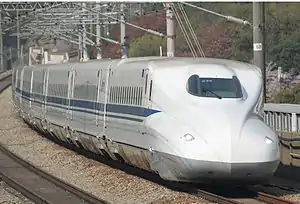
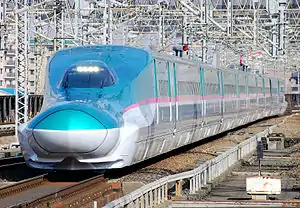
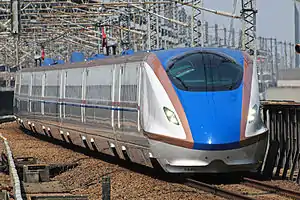
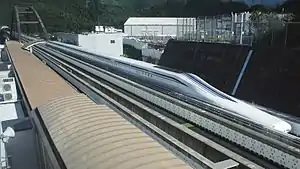
.svg.png.webp)
.svg.png.webp)